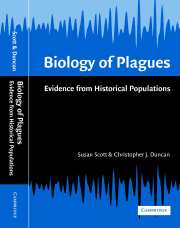Book contents
- Frontmatter
- Contents
- Preface
- Conversion table for imperial to metric units
- 1 Introduction
- 2 Epidemiological concepts
- 3 The biology of bubonic plague
- 4 The Great Pestilence
- 5 Case study: the plague at Penrith in 1597–98
- 6 Pestilence and plague in the 16th century in England
- 7 Plagues in the 16th century in northern England: a metapopulation study
- 8 Plagues in London in the 17th century
- 9 Plagues in the provinces in the 17th century
- 10 Plague at Eyam in 1665–66: a case study
- 11 Continental Europe during the third age of plagues: a study of large-scale metapopulation dynamics
- 12 The plague at Marseilles, 1720–22: an outbreak of bubonic plague?
- 13 Conclusions
- References
- Index
11 - Continental Europe during the third age of plagues: a study of large-scale metapopulation dynamics
Published online by Cambridge University Press: 28 October 2009
- Frontmatter
- Contents
- Preface
- Conversion table for imperial to metric units
- 1 Introduction
- 2 Epidemiological concepts
- 3 The biology of bubonic plague
- 4 The Great Pestilence
- 5 Case study: the plague at Penrith in 1597–98
- 6 Pestilence and plague in the 16th century in England
- 7 Plagues in the 16th century in northern England: a metapopulation study
- 8 Plagues in London in the 17th century
- 9 Plagues in the provinces in the 17th century
- 10 Plague at Eyam in 1665–66: a case study
- 11 Continental Europe during the third age of plagues: a study of large-scale metapopulation dynamics
- 12 The plague at Marseilles, 1720–22: an outbreak of bubonic plague?
- 13 Conclusions
- References
- Index
Summary
Hitherto, after the pandemic of the Black Death in 1347–50, we have described the plague epidemics in successive centuries in England and have seen that it was an isolated island metapopulation that was completely dependent, if plagues were to be maintained, on regular injections of fresh infectives from overseas, which came, in the main, from the ports of continental Europe. We explore in this chapter the dynamics of the plague in the enormous metapopulation of Europe and show that it can be considered as an aggregation of subpopulations.
Consideration of plagues in Europe is complicated because, certainly by the 16th century, in addition to the ‘standard’ (haemorrhagic) plague that we have described in England, there were a minority of outbreaks of genuine bubonic plague. A nucleic acid-based confirmation of the existence of Yersinia pestis has been obtained in the dental pulp of bodies buried in the Provence region in the 14th, 16th and 18th centuries (Drancourt et al., 1998; Raoult et al., 2000). In addition, Twigg (1984) concluded that bubonic plague was present in some of the epidemics in the 6th century in the coastlands around the Mediterranean. Black rats had not reached northern Europe by the time of the plague of Justinian (Shrewsbury, 1970), but Twigg presumed that they were present in the ports and major cities in the warmer climate around the Mediterranean and would have been able to sustain small outbreaks of bubonic plague.
- Type
- Chapter
- Information
- Biology of PlaguesEvidence from Historical Populations, pp. 284 - 337Publisher: Cambridge University PressPrint publication year: 2001



